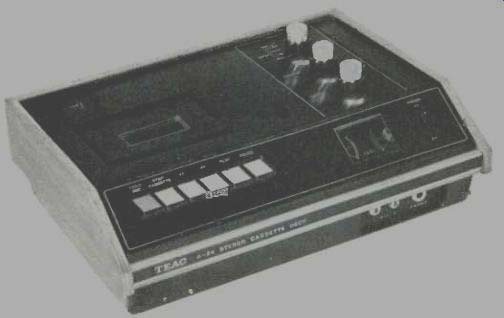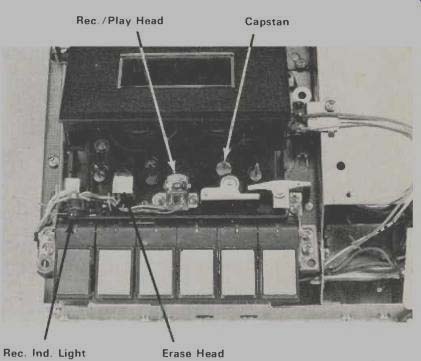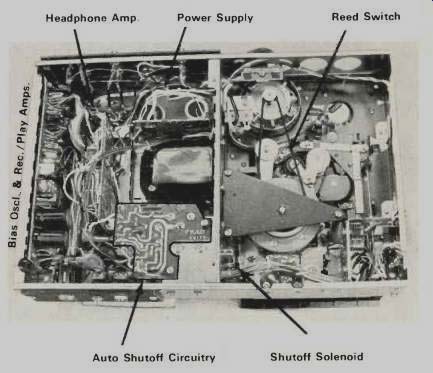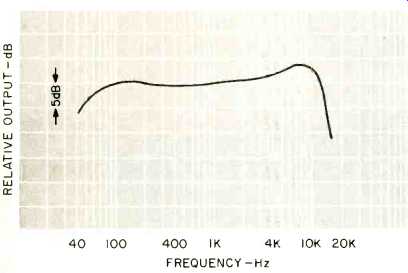
MANUFACTURER'S SPECIFICATIONS
Track System: 4-track, 2-channel, stereophonic system.
Compatible Tape: C-60, C-90 Philips-type cassette tapes.
Tape Speed: 1 7/8 ips. Wow-Flutter: 0.2%.
Fast-Forward Time: Approx. 70 seconds with C-60 tape.
Signal-To-Noise Ratio: More than 45 dB.
Frequency Response: 40 to 12,000 Hz.
Inputs: Microphone, 0.3 mV (-70 dB) at 600 ohms; Line and Tuner, 0.1 V at 50,000 ohms.
Outputs: Line, 0.3 V at 10,000 ohms load; Headphone, 8 ohms.
Power Requirements: 117 V a.c., 60 Hz.
Power Consumption: 20 W maximum.
Dimensions: 13 5/8 in. W, 9 3/8 in. D, 4 1/4 in. H.
Weight: 11 lbs. net.
Price: $ 179.50.
The increasing popularity of cassette tape practically demands that some model of cassette recorder he included in any modern hi-fi installation. And there is an enormous selection of them available today--45 of them in the high-fidelity category were listed in the September Buyers' Guide issue, and there are many more than that on the market, although not all by any means could be called hi-fi, even though they are so labeled.
Improvements in tape formulations, increased bias current, Dolby systems, and reduction of wow and flutter as a result of more-precise manufacturing, and the use of hysteresis motors have all contributed to the better performance obtainable from cassette recorders and players on the market today. The A-24 employs most of these features.
In addition to having the usual compartment for the cassette, there are six "piano-key" controls which effectuate all tape-motion functions. At the left is the red RECORD key. To record, this key is depressed simultaneously with the PLAY key; both remain down and the recording function is indicated by an illuminated jewel just above the RECORD key. The next key is labeled STOP AND CASSETTE. If the machine is winding tape, either in the play or record modes or in either of the fast directions, the tape motion simply stops. If the tape is stopped, the door of the cassette compartment snaps open and the cassette is pushed forward enough to he easily picked up with the fingers. When the door is opened, a cassette may be inserted in the plastic track on the underside of the door and pressed until it clicks. Closing the door engages the hubs of the cassette with the reel spindles. The next key is the REWIND control. When this button is depressed the tape is rewound to the left spool; when completely wound, the drive shuts off automatically. The next key is for FAST-FORWARD motion, but it does not stay down-it must be held with the finger as long as the tape is being moved forward. The two fast-wind keys are indicated by arrows pointing in the direction of tape motion.
The next key is the PLAY control. When it is depressed, the tape proceeds at its leisurely I 78-ips speed under control of the capstan and pinch roller. The last key, marked PAUSE, lifts the pinch roller slightly so the tape does not move. This is convenient when starting to record, since with the machine in the record mode levels can be set without actually recording the tests which almost always precede a recording session.
Furthermore, it permits the user to make those occasional pauses in a performance-station breaks, and so on-that if recorded would mar an otherwise unblemished recording.
One of the protective features of the A-24-although no harm would likely result-is that the PLAY key cannot be depressed unless the cassette holder is closed. How to record on a cassette which has the protective tab broken off will be described later-though perhaps you shouldn't know it if you have a lot of recorded cassettes.
Further to the right is the dual record-level meter, which indicates the signal during recording to aid in getting the right level on the tape, and it also indicates the output level while playing back--always a useful feature.
On the flat top surface of the recorder is a panel with three sets of controls. At the rear is a four-position switch which selects inputs from the LINE input jacks or from the TUNER input jacks, or from two of the five terminals on a DIN socket on the rear apron, or, in the same position, from microphones which plug into miniature phone jacks on the lower front of the cabinet, just under the record-level meters. When microphones are plugged in, the DIN-plug input is disconnected.
The fourth position of the switch is for playback.
Forward of the switch is next a dual-concentric record-level control, and forward of it another dual control for playback level, or actually for the level at the LINE output jacks and the stereo headphone jack adjacent to the microphone jacks, because a signal is present at these points during recording-the source, naturally.

Fig. 1-View of the cassette compartment showing the positions of the two heads,
the capstan, and the record indicator light.

Fig. 2--The underside of the chassis showing locations of the main circuit
boards and the reed switch, which actuates the shutoff mechanism.
Circuit Description
The amplifier circuitry in each channel consists of a single transistor input stage operating at increased gain for playback, and at somewhat reduced gain for recording. It is followed by the record level control which is simply the variable shunt resistor of a "T" attenuator network. This stage, with its switched record-level control, next drives a feedback pair, with different equalizations being selected by the switch to suit the requirements of recording and playback. The playback level control follows, and its output feeds the output jacks as well as a transistor stage which drives the level-indicating meter. One additional stage driven in parallel with the playback level control serves as the record head driver, which has additional equalization in its emitter circuit and a bias trap in the output. The output line also feeds a single-transistor amplifier stage which is transformer coupled to the 8-ohm headphone jacks.
A single transistor serves as the bias oscillator, with erase signal fed from the secondary of the oscillator transformer, and the bias signals fed through adjustable capacitors to the two record heads. The split-primary power transformer (for operation on either 117 or 240 volts) has two secondaries--one to drive the single hysteresis motor (at about 50 volts) and to feed a full-wave rectifier system to provide the 28 volts d.c. for the amplifier section, and a 5-volt winding for the meter-illuminating lamps (which indicate POWER ON) and the record indicator lamp.
The automatic-stop circuit is intriguing. Whenever the unit is in any of the tape-moving modes, a relay is energized and its contacts, which are in series with the shutoff solenoid, are open. The relay is energized by the collector current through two transistors in series to ground. The bases of the transistors are connected together through a time-constant network by a reed switch which is alternately opened and closed by a magnet in a rubber idler wheel which is rotated by the takeup spindle. When the spindle stops (or when power is shut off) the reed switch becomes stationary--either open or closed.
When the time constant between the bases expires, one of the transistors shuts off, releasing the relay, and its non-operate contacts close, causing the solenoid to operate to shut off the unit, which it does by releasing any of the keys which were depressed. All of this takes place fast enough so the d.c. stored in the filter capacitors is still sufficient to actuate the solenoid.
Some similar circuitry is commonly used in the better cassette machines, but this is the first one using this particular type of releasing mechanism-most we have observed simply cut off the a.c. power to the motor. In all, there are 15 transistors and five diodes in the electronic portion of the A-24.
Performance
Frequency response-one of the most looked-for parameters in any tape recording equipment-is shown in Fig. 3. Still more important, perhaps, is the percentage of wow and flutter, which measured at 0.09 percent in the range from 0.5 to 6 Hz, 0.11 from 6 to 250 Hz, and 0.16 percent over the whole band. Distortion at "0" recording level measured 1.2 percent, while the 3 per cent point was reached at an indicated recording level of +4 dB. The input signal required for "0" level was 84 mV from the line and tuner inputs, as well as from the DIN socket. From the microphone jacks, an input of 0.35 mV was sufficient to provide the same recording level, all with the record-level controls at maximum. The same recorded signal from the tape provided a line output of 0.7 volts with the playback level control at maximum, and an output of 0.21 volts at the 8-ohm headphone outputs. Signal-to-noise ratio was a comfortable 47 dB, and due to the good track spacing, stereo separation was 32 dB--about normal for cassette tapes.
Crosstalk between tracks recorded in the forward direction and playback from tapes played in the reverse direction was 43 dB. Both rewind and fast-forward times for a C-60 cassette were measured at 65 seconds. Bias oscillator frequency was 85 kHz, which is comparatively high for cassette decks.
A removable cover plate on the right end of the chassis gives access to the main printed-circuit board for adjustment of bias level. A 0.5-amp. fuse protects the unit against failure of any power supply components. Both the motor rotor and the flywheel are dynamically balanced. Not mentioned in the instruction booklet is the fact that both motor and flywheel-which is on the capstan shaft-have two grooves on their pulleys so the machine could be converted to 50-Hz operation in minutes.

Fig. 3--Frequency response for a signal recorded and played back. Recording
input level was 15 dB below indicated "0" level. Tape used was a
TDK C-60SD cassette.
The construction of the A-24 is apparently meticulous throughout. In many recorders and decks, we have noticed that the meters were held against the front panel by foam pads without any other fastening to keep them in place, so they depended solely on the pressure of the cover panel to locate them accurately. In this machine, however, while a foam pad was used to mount the meter, the two were cemented together and to the chassis so the meter remained in the correct position even when the housing was removed.
The TEAC A-24 cassette deck is easy to handle, effective in its performance, and an overall delight. It should do a lot toward carving a niche in the home music system for cassette machines. The instruction book accompanying the unit is complete and should serve as a good introduction to tape recording for the complete novice. For instance, the instructions tell how you can defeat the anti-erase feature common-to all cassette machines-the protection offered to a cassette when the safety tab in the back of the cassette is broken out--you simply depress the RECORD key before inserting the cassette. One other provision in the instruction book is the inclusion of a schematic. While it is not expected that the owner will ever service his machine, it is possible that some technician might have occasion to do so and the presence of the schematic could be a great help.
-C.G. McProud
=================
(Adapted from Audio magazine, Apr. 1972)
Also see:
Teac Z-7000 Cassette Deck (May 1984)
TEAC Model C-1 Cassette Deck (Equip. Profile, Dec. 1979)
Teac X-20R Open-Reel Recorder (Equip. Profile, Mar. 1982)
Teac Model AS-200U Amplifier (Mar. 1970)
Technics Model RS-616 Cassette Deck (Feb. 1979)
= = = =